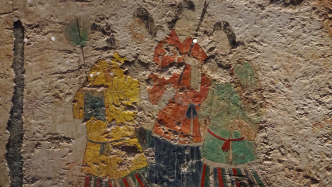
The Paper learned that "Aesthetics Across Two Countries: Cultural Exchanges Between Japan and China during the Han and Tang Dynasties" was recently exhibited at the Art Museum of Tsinghua University. This exhibition is an overall review of the history of Japan and the history of Sino-Japanese exchanges. It presents more than 100 pieces (sets) of cultural relics related to China from institutions such as the Kashihara Institute of Archaeology in Nara Prefecture, as well as dozens of cultural relics collected by domestic cultural and museum institutions. There are many cultural relics related to Japan, many of which are exhibited abroad for the first time.
The surging journalists saw at the scene that the exhibition started from the era of accepting the Chinese emperor's canonization of the "Japanese King" to rule the "Japanese kingdom", and continued to break away from the canonization system. After learning various systems and cultures from China, the establishment of the emperor-centered The ancient law country "Japan".

"Aesthetics Across the Two Countries: Cultural Exchange Between Japan and China during the Han and Tang Dynasties" exhibition site
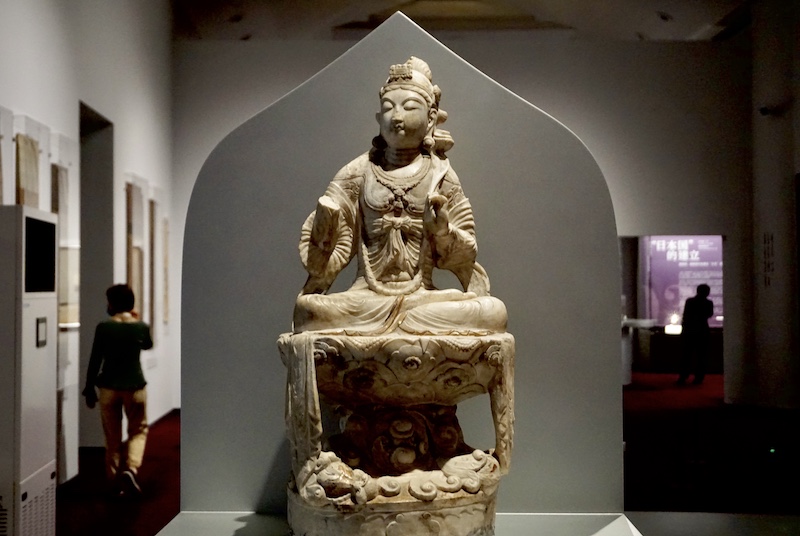
"Aesthetics Across the Two Countries: Cultural Exchange Between Japan and China during the Han and Tang Dynasties" exhibition site
In addition, the exhibition also focuses on showing the grand occasion of Buddhist culture in Japan, displaying various cultural relics made in Japan and Japan, as well as paintings related to Nara and reproductions of murals restored by modern technology, in order to explore the long history of China and Japan The history of cultural exchanges between the two countries.
From the Jomon period
"Japanese" is the name given to Japanese in China before the establishment of "Japan". The Japanese also called themselves "Japanese" or "Japanese", and their rulers paid tribute to China in the name of "Japanese King" or "Japanese King". With the recognition of the Chinese emperors, the Japanese rulers exercised domestic rule in Japan.
The activities of the Japanese began in the Paleolithic period. During the Jomon period, the Japanese began to use bows and arrows and polished stone tools while using pottery. Although hunting and gathering were their main occupations, they also lived a settled life in settlements. Large-scale buildings were built in the center and edges of the settlements, and terracotta figurines, stone rods, etc. were used to perform sacrifices, etc., and the spiritual culture developed unprecedentedly. Entering the Yayoi period, the Japanese introduced irrigated paddy field farming technology from the mainland and fixed it. As development progressed, productivity increased by leaps and bounds.
The painted pottery on some of the pottery in the exhibition depicts the daily life and sacrifice scenes of people in the Yayoi period. With the accumulation of wealth, tribal leaders were born, and tribal states were gradually formed. The kings of the tribal nations began to communicate with China.
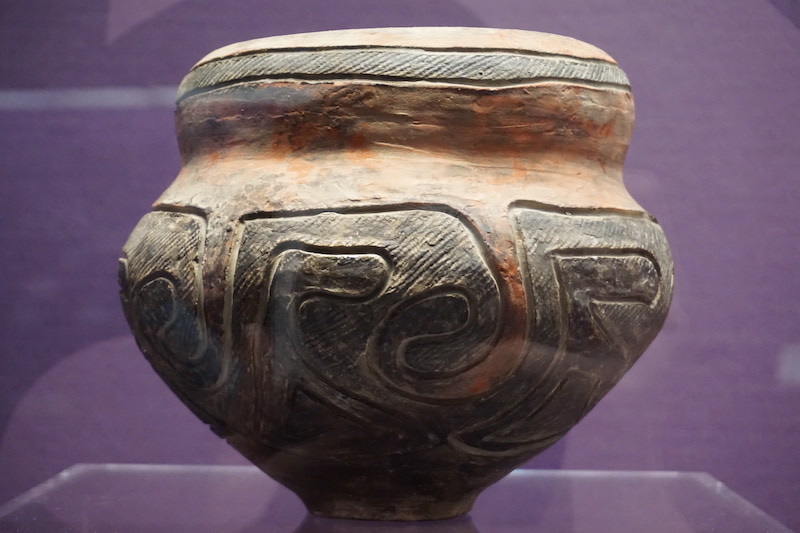
Jomon period pottery

Yayoi period pottery pottery fragments

Yayoi period pottery pottery fragments
Deer is the most common animal image on decorative pottery in the Yayoi period. The following exhibit features two female deer and a building on the body. There are several upward straight lines between the deer facing the left and the building (the roof is divided into four slopes: front, rear, left and right). If this straight line is an arrow, it should be depicting a scene where the deer is shot from the building and the deer flees in panic.
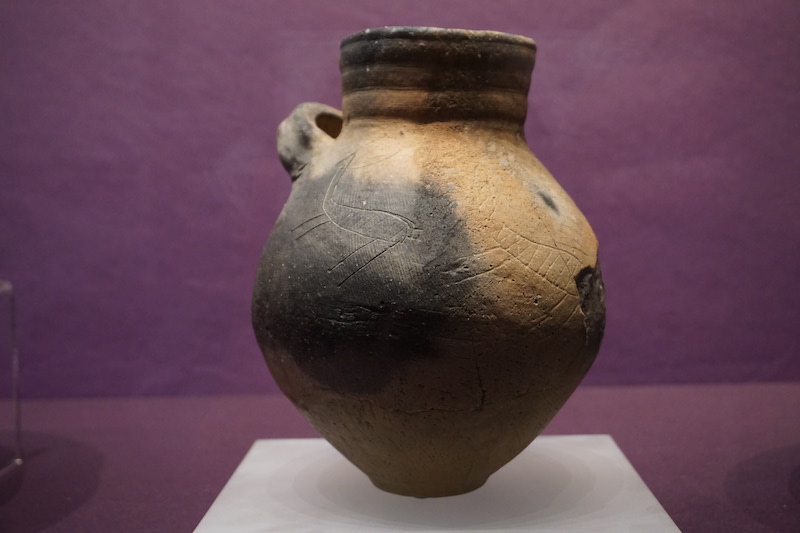
Buildings and Deer Pottery
The rarest exhibits in this section are the pottery figurines and special utensils of the Kofun era.
After the Yayoi period, Japan entered the Kofun era, which was named after the huge early mounds of mounds scattered throughout Japan, many of which spanned nearly 2,000 years and are still well-preserved.
There can be many observation angles about the huge ancient tombs, such as the most discussed, whether it is influenced by the Chinese tomb culture, such as the most famous huge tomb in China - Qin Shihuang Mausoleum, as well as the Northern Wei Dynasty at the same time as the ancient tomb era. Ancient tombs left. The huge ancient tombs are very different from the Chinese tombs. The huge ancient tombs in Japan are mounds of earth, and coffins are placed on the top of the mounds to bury the dead. There is no underground palace that Chinese tombs have bothered to build. The funerary objects in the Chinese underground palace, in the huge ancient tombs, are abstracted as haniwa, and they are placed on the ground layer by layer along the central area of the tomb, like guards. What is more different from the Chinese tombs is that of the 150,000 ancient tombs in Japan, only 20 of them are known to be buried.
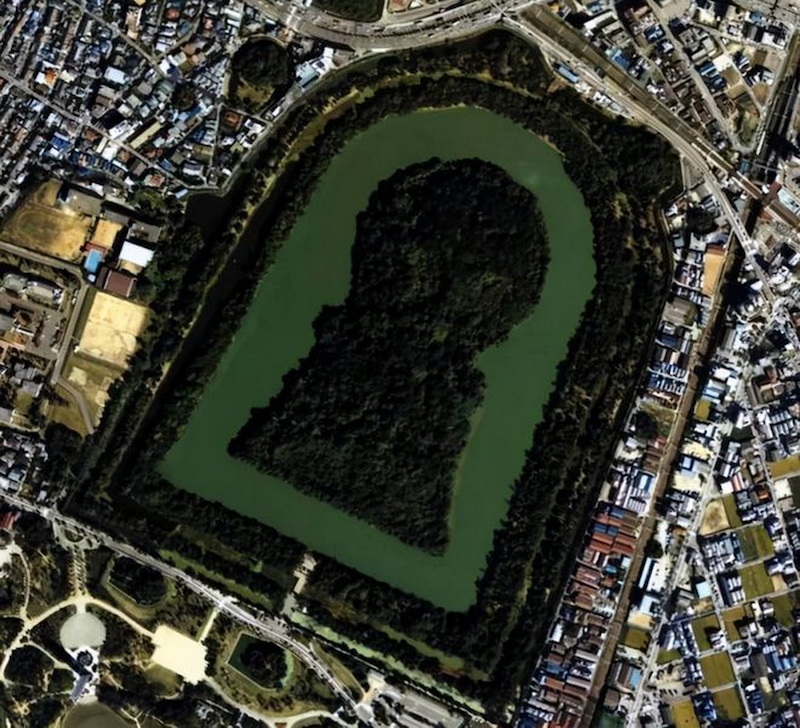
Overlooking the famous Oyama Kofun
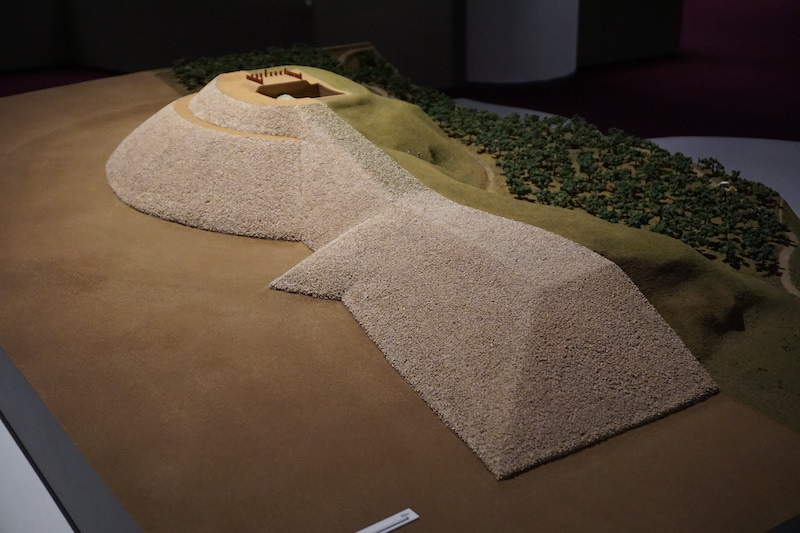
The model of the front and rear round tombs displayed in the exhibition
Art historian Xu Xiaohu said in "History of Japanese Art":
The biggest feature of the ancient tomb culture is the human-shaped pottery (figure han round), which was later transformed into a cylindrical shape and placed in concentric circles along the central area of the tomb. There are also earthen shields and ceremonial awnings around the house. At the end of the 4th century, human-shaped pottery tended to be the same as god and man, and the hollow body was decorated with delicate clothing; in the 6th century, animal pottery such as chickens, horses, wild boars, deer, dogs, cats, cows and fish appeared one after another, facing outward. The poses are placed in rows on the mound, and the sacred central area houses birds, boats, and houses, which should symbolize the means of transport that lead the soul to its final resting place.
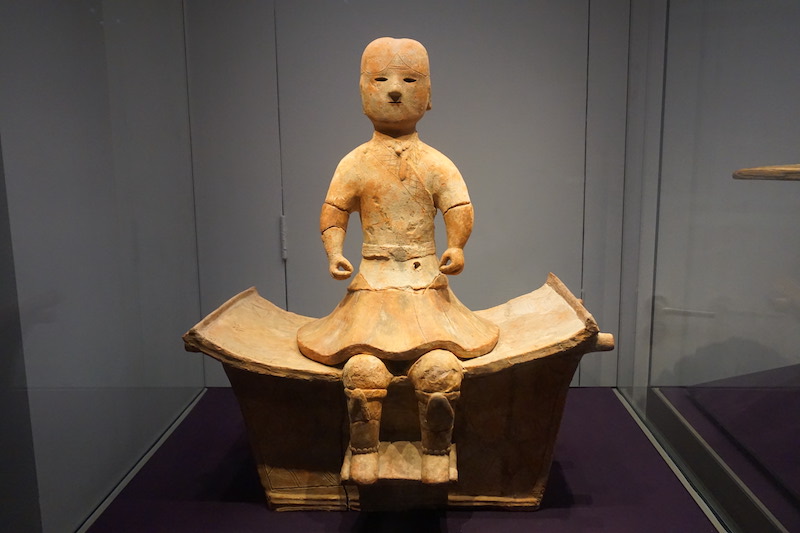
Kofun Period Character Hanawa
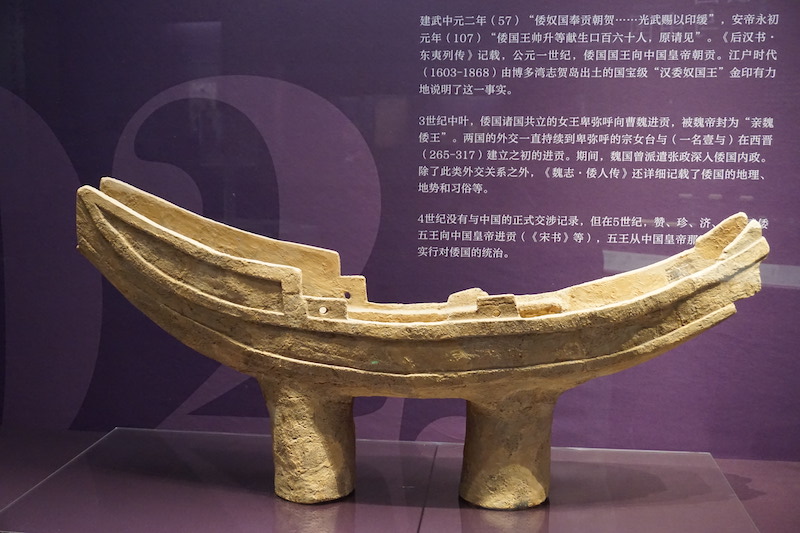
Kofun Period Funagata Hiwawa
The special table is used to support special pots. In the cemeteries in the central area of Okayama Prefecture, the offerings of the utensils with the arc-band pattern are called special utensils, and those that match the special utensils are called special pots. On the one hand, the two developed as pottery for tomb offerings, and on the other hand, the design of the arc-stripe pattern continued to degenerate, and finally formed a cylindrical haniwa with the bottom of the pot and the arc-stripe pattern removed.
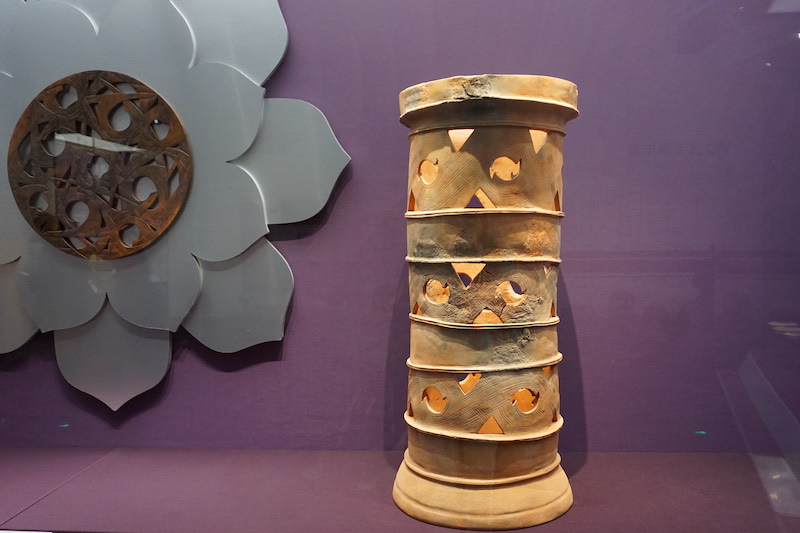
special utensils special pots
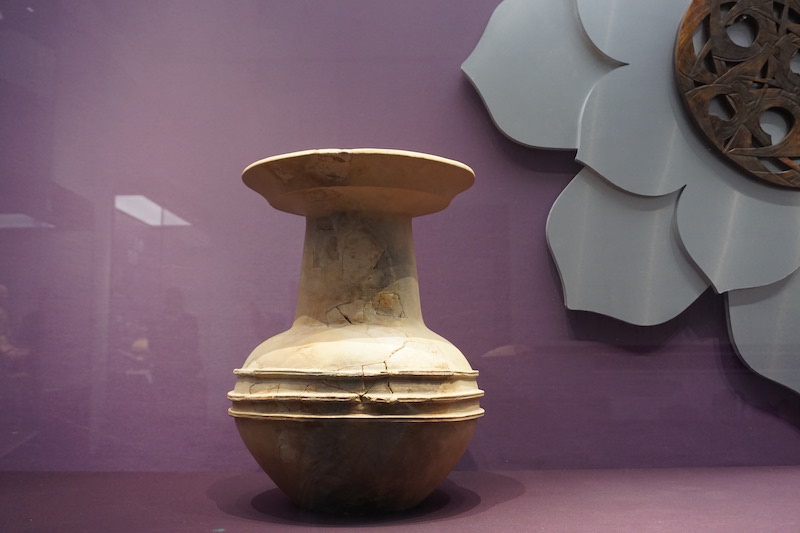
special utensils special pots
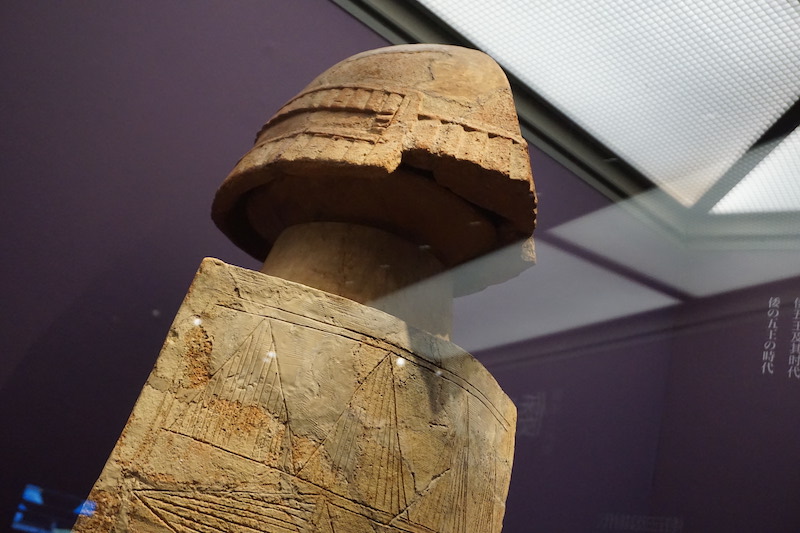
Armor and shield pottery
The exhibition also features replicas of two gold ornaments. One is a replica of the gilt bronze crown. The body of the golden crown is called "Guangdai Ershan Style", with raised parts on both sides and a butterfly-shaped decoration in the middle. The tree-shaped uprights attached to the main body are decorated with fern-shaped hanging baskets, sword-shaped diamonds, and bird-shaped decorations. Whether it is the main body or the vertical decoration, dotted or straight lines are carved on the bottom plate, and the heart-leaf or bird-shaped steps are embellished with iron wires. The "Guangdai Ershan style" and the vertical decoration are unique shapes and designs of the Japanese. On the other hand, the designs of tree-shaped ornaments, including Silla on the Korean peninsula, have also been pointed out to be related to the excavations of the Tira Hills in Afghanistan.
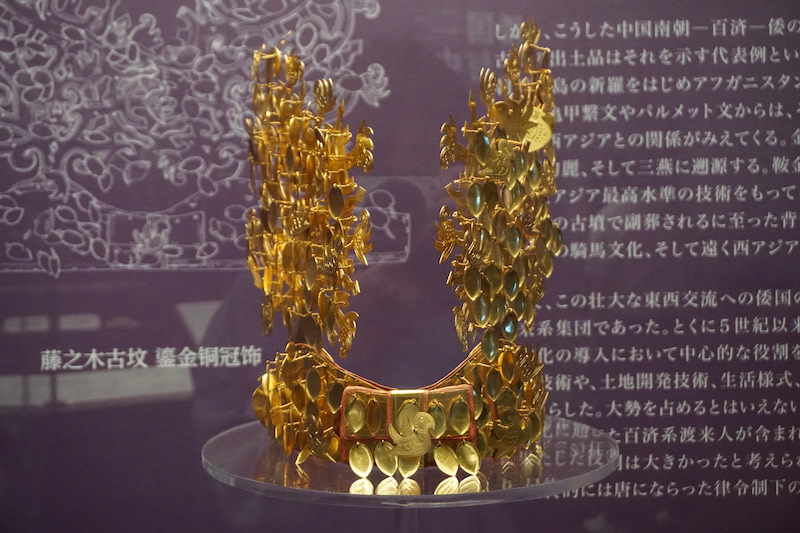
Gilt bronze crown (replica)
The Asuka Age and the "Foundation of Japan"
The Asuka era is a historical period in ancient Japan. It began in 592 when Japan's first female emperor pushed the ancient emperor to the throne, and ended in 710 when the capital was moved to Heijo-kyo.
During the Asuka era, the Japanese state sent envoys to the Sui Dynasty in the 20th year of Emperor Kaihuang of the Sui Dynasty. In the third year of Sui Daye, the Japanese state claimed to be "the Son of Heaven at the Sunrise" in the letter of credentials to the Sui Dynasty, which angered Emperor Yang of the Sui Dynasty. The following year, Emperor Yang of the Sui Dynasty sent Wenlin Lang Pei Shiqing to Japan to show his admonition. In 618, after the establishment of the Tang Dynasty, the Japanese state dispatched Tang envoys. The foreign students and monks learned a lot from the Sui and Tang Dynasties, which was related to the establishment and development of the "Japan", a country of laws centered on the emperor.
In 672, the largest civil war in ancient Japanese history, the "Ren-Shin Rebellion", took place the following year at the Asukajing Mihara Palace. After that, the construction of the country under the law centered on Emperor Tenmu accelerated. After that, the "Dabao Law" was compiled and completed in the first year of Dabao. In this way, the "Japan" national system centered on the "Emperor" was finally established. In the same year, the envoy to Tang was reappointed. In the second year of the Great Treasure, the ambassador of the "Japan" Awata Shinto entered the Tang Dynasty, and Wu Zetian gave a banquet to give officials. Since then, the country name "Japan" has been officially used externally.
During this period, the exchanges between China and Japan became more and more close, and many cultural relics also showed traces of exchange and integration. For example, a bone utensil containing cremated bones was unearthed in the hills of the cave insects in Kaoshiba City, Nara Prefecture. As a cast gold-plated container, the lid and the body are hemispherical, and the junction is in the form of a seal lid where the lid and body are combined. The cover is basically 10 characters per line, with a total of 391 characters engraved in a radial pattern. It is rated as the best Chinese epitaph in Japan. The inscription reads: Weinai Omura once served Emperor Chitong and Emperor Wenwu, and in the second year of Qingyun became the fifth Shimo Echigo Castle Secretary. Qingyun died in office in the fourth year at the age of 46.

Weinai Omura Ossuary
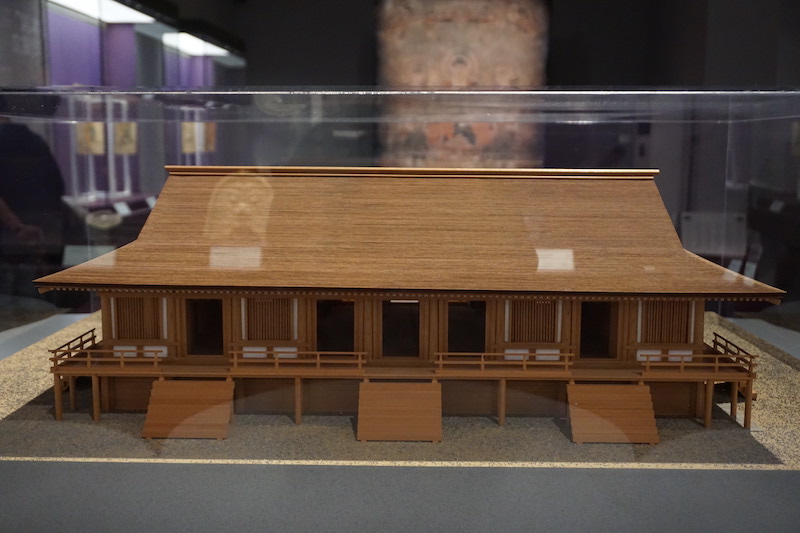
Architectural model of the main hall of Asuka Jingyuyuan Palace
In the Asuka era, "thin burials" were advocated, and octagonal tombs were used in the Mausoleum of the Emperor. The joint tomb of the Qiming Emperor and his daughter-in-law is considered to be the ancient tomb of the Octagonal Tomb.
Both the Takamatsuzuka burial mound and the turtle and tiger burial mound were built in the late 7th and early 8th centuries in the form of two-stage circular burials. The structure of the cross-mouth stone coffin of the Takamatsuzuka Kofun is a box-shaped structure consisting of bed stones, wall stones and cap stones. The inner surface is painted with stucco and painted with frescoes. The painting content includes four gods, namely the blue dragon on the east wall, the white tiger on the west wall, the Xuanwu on the north wall and the Suzaku on the south wall; figures (4 men and 4 women, on the east and west walls); the sun on the east wall and the moon on the west wall and the constellation of the ceiling. The Takamatsuzuka burial mound and the turtle and tiger burial mound are the only known Japanese tombs with murals depicting the Four Gods and the constellations.

Takamatsuzuka Kofun Mural Characters
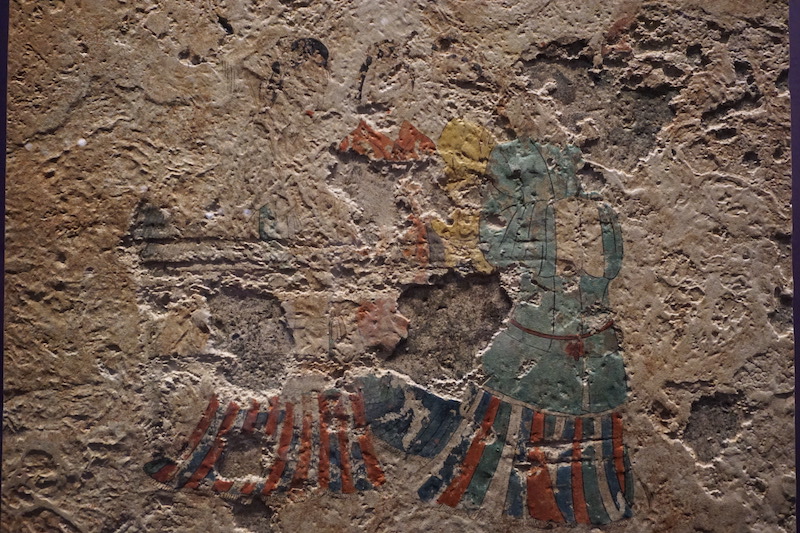
Takamatsuzuka Kofun Mural Characters
Since the discovery of the Takamatsuka burial murals, its relationship to the Tang and Goguryeo has been discussed. The constellation map, the four gods map and the group of figures are common themes of the murals in the ancient tombs of the Sui and Tang Dynasties, and the group of figures also appeared frequently in the murals of the Chinese tombs after the second half of the 7th century. In the tomb of Prince Yide (706), the figures are rendered three-dimensionally through the perspective method of overlapping front and rear, as is the group of women on the west wall of Takamatsuzuka.
Tang Sancai is widely used in Tang tombs as bright objects. Tang Sancai decorated with bright colors such as green, brown, white, and blue was also brought to Japan, and Nara Sancai, which imitated Tang Sancai, was also produced in Japan. Nara Sancai is thought to have been fired in and around Heijo-kyo. In the document of Shoso-in Todaiji Temple, there is a "crop tent for Buddha making", from which you can appreciate the production technology of Nara Sancai.
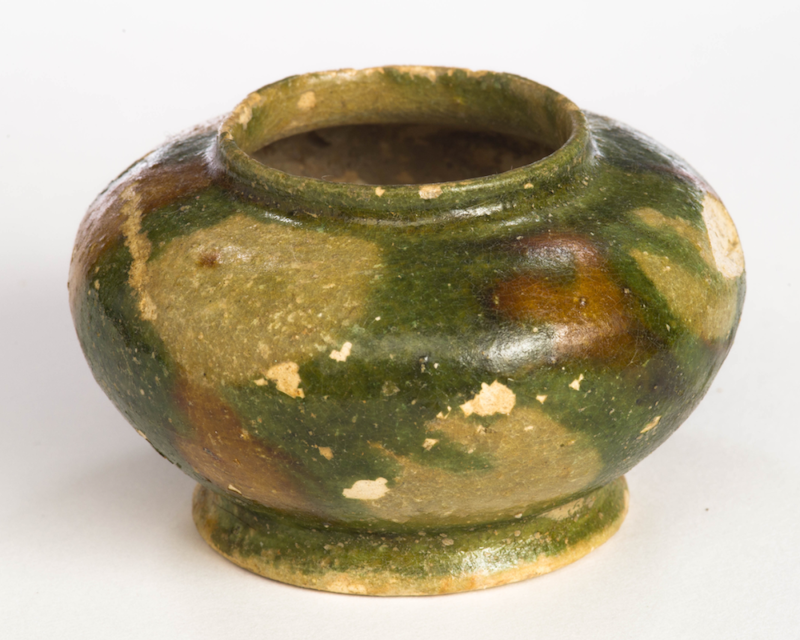
Nara three-color pot
The image of prayer and Japan from a Chinese perspective
Buddhism, which originated in India, was introduced to the island nation at the eastern end of Eurasia through Central Asia, China, and the Korean Peninsula around the middle of the 6th century. The origin of Yuanxing Temple is recorded in 538 AD, and the Nihon Shoki records in 552 AD. This year, King Seongmyeong of Baekje presented a Buddha statue, solemn tools and Buddhist scriptures. This is the so-called public transmission (official transmission) of Buddhism. According to the "Nihon Shoki", after seeing the statue of the exotic deity named Buddha, Emperor Qinming commented that his posture was upright and solemn. Since then, Japan has sought norms from the knowledge gained from exchanges with dynasties on the Korean peninsula and mainland China at that time, and at the same time carried out acts of manifesting the sacred.
An interesting example of the spread of Buddhist images is the Brick Buddha.
In Japan, the production of relief statues, which were molded from clay and fired, was carried out in the late 7th and early 8th centuries. In the early Tang Dynasty, after Xuanzang returned from his westward journey to seek Dharma in 645, Indian-style brick Buddha production was prevalent in the capital Chang'an. The envoy to the Tang Dynasty brought it back, which contributed to the rapid spread of brick Buddha making in Japan. It can be said that the brick Buddha, which can be reproduced in large numbers through molds, played a crucial role as a medium connecting the beauty and spirit of ancient Asia.
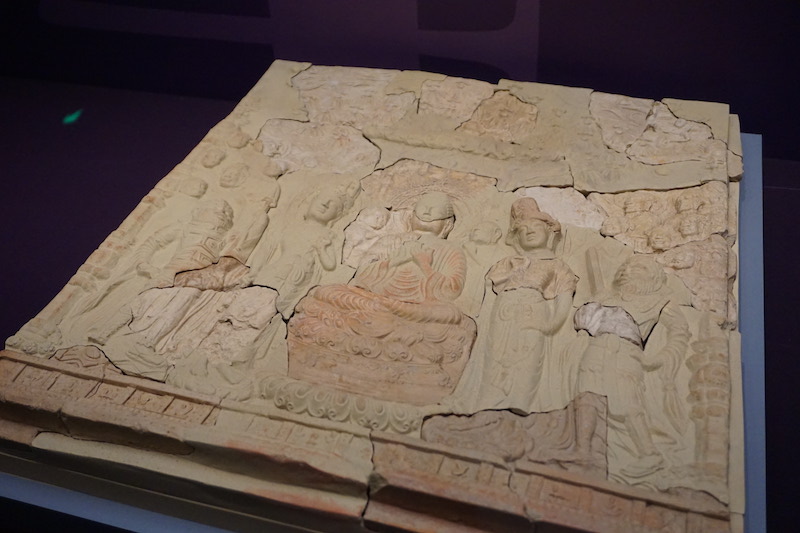
Asuka era, many statues of Buddha bricks
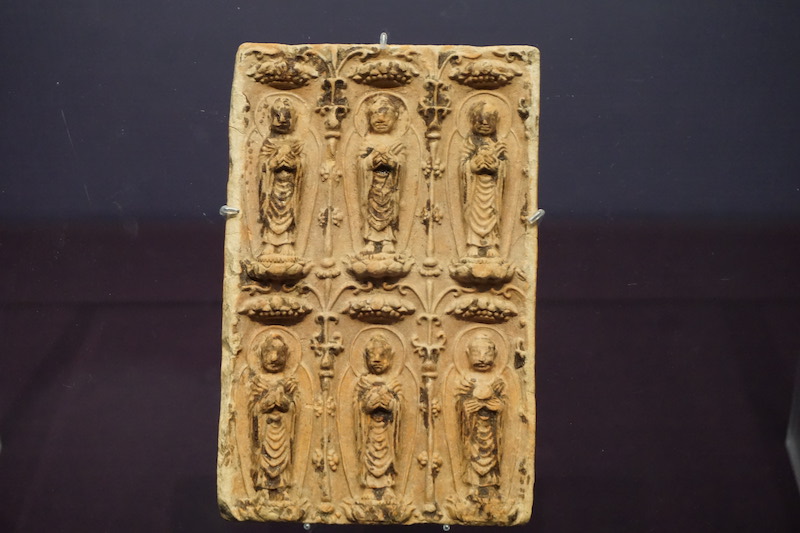
Asuka era six square statues of brick Buddha
In addition, in order to show Japan from a Chinese perspective, the exhibition also selects relevant cultural relics, such as bronze mirrors, metal products, bricks, Buddha statues, epitaphs, etc. It shows the cultural exchange between ancient China and Japan from some specific angles.
For example, during the Three Yan Period of the Sixteen Kingdoms (337-370 of the former Yan, 384-407 of the latter Yan, and 407-436 of the Northern Yan), metal products, such as trotters, gold utensils, horse gear, etc., are used to make up for the three missing items in the official history with physical evidence. The history of Sino-Japanese exchanges from the late 19th century to the early 5th century.
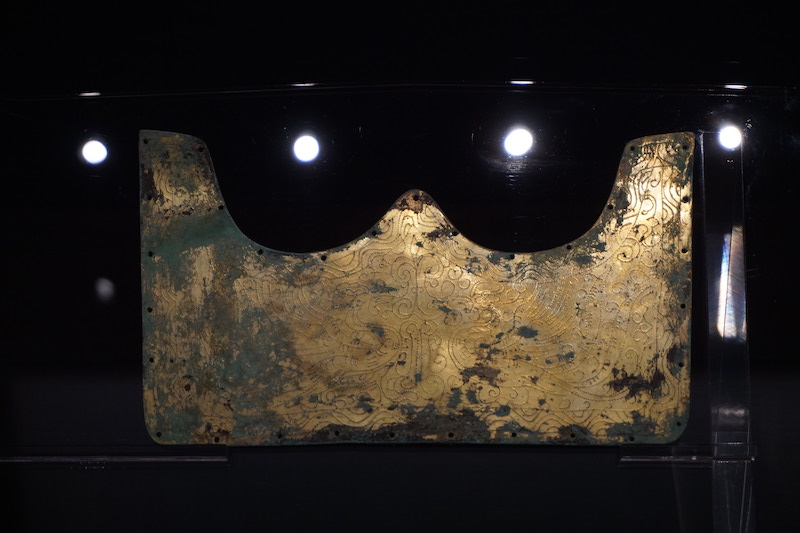
Former Yan of the Sixteen Kingdoms, gilt bronze engraved phoenix pattern Yamagata arrow ornament, Chaoyang County Cultural Relics Management Office
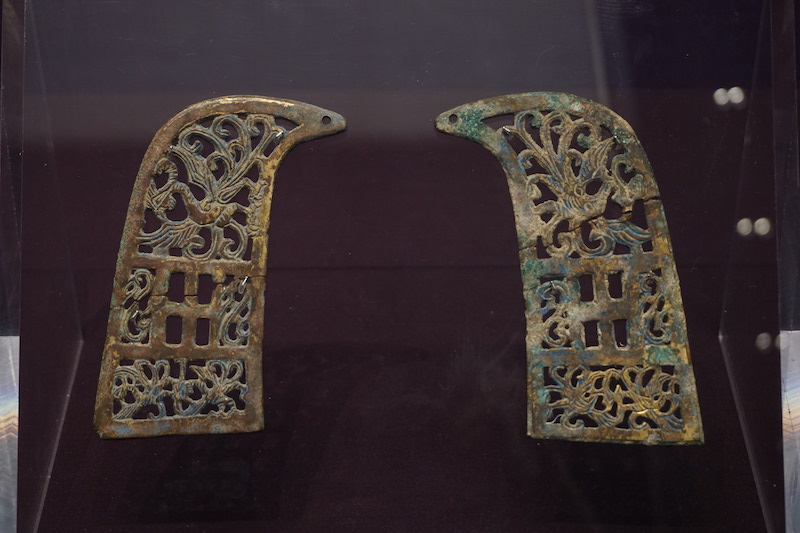
Openwork gilt bronze harness accessories (front bridge) Sixteen Kingdoms Qianyan

Jin Buyao Sixteen Kingdoms Qianyan
In addition, the exhibition also displays the portrait bricks from the Jin Dynasty to the Southern Dynasties from the Three Kingdoms. From the perspective of decoration, such as the four gods, lotus, buildings, Buddha statues, gods, etc., we can see the close communication between China and Japan at that time. Buddha statues are important material materials for the study of esoteric sculptures in Chang'an temples and Japanese esoteric sculptures in the prosperous Tang period; the epitaph of Li Xun and Jing Zhencheng, the epitaph of "Japanese court officials", are important materials reflecting the history of envoys sent to the Tang Dynasty. History of the Korean Peninsula, an important mediator of Japanese cultural exchanges, etc.
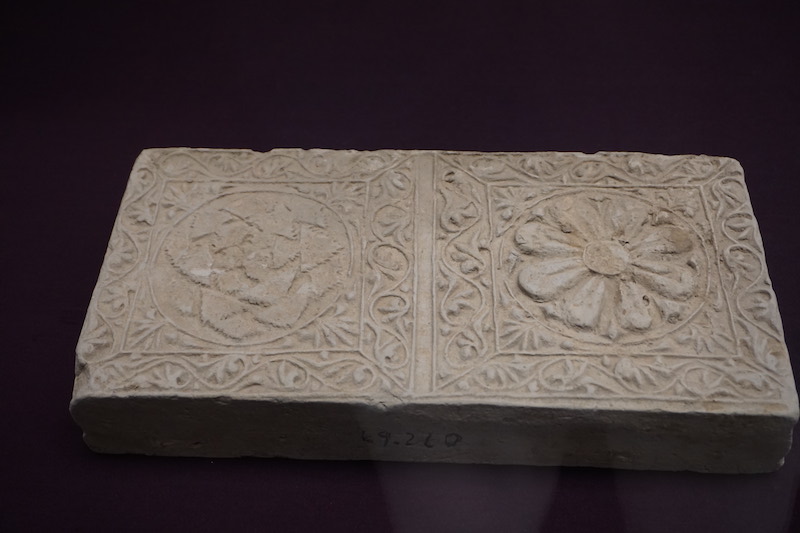
Rectangular plane rhombus leaf pattern, lotus pattern portrait brick

Tang Baishi Seated Statue of King Ming Dynasty, Xi'an Forest of Steles Museum
It is reported that the exhibition will last until December 4th.